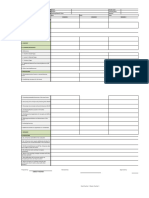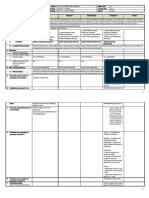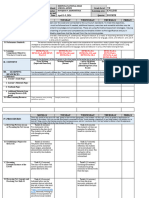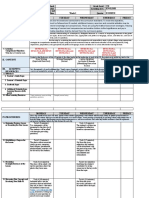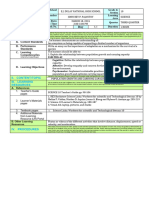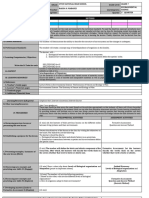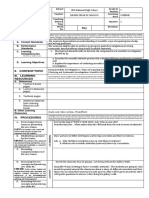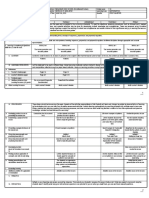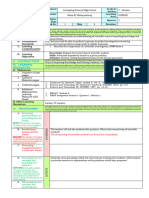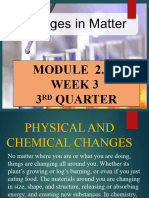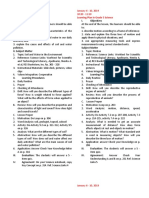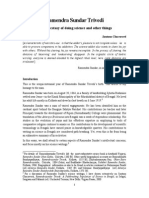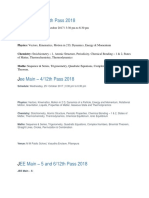My Daily Lesson Plan
My Daily Lesson Plan
Uploaded by
C Aina Myles CabatbatCopyright:
Available Formats
My Daily Lesson Plan
My Daily Lesson Plan
Uploaded by
C Aina Myles CabatbatOriginal Title
Copyright
Available Formats
Share this document
Did you find this document useful?
Is this content inappropriate?
Copyright:
Available Formats
My Daily Lesson Plan
My Daily Lesson Plan
Uploaded by
C Aina Myles CabatbatCopyright:
Available Formats
School PDMHS Grade Level 8
Teache CRISANTO C. CABATBAT Learning Area SCIENCE
r and
Teaching Dates
February 5-9, 2024 Quarter 3RD
Time
MY DAILY LESSON DAY: 1 DAY: 2 DAY: 3 DAY: 4
PLAN SECTION TIME
I.OBJECTIVES HUMILITY 3:50-4:50 PM
KINDNESS 4:50-5:50 PM
Objectives must be met over the week and connected to the curriculum standards. To meet the objectives necessary procedures must be followed and if needed additional lessons exercises and remedial activities maybe
done for developing content knowledge and competencies. These are assessed using formative assessment strategies. Valuing objectives support the learning of content and competencies and enable children to find
significance and joy in learning the lessons. Weekly objectives shall be derived from the curriculum guides.
A.Content Standards The learners demonstrate understanding of the particle nature of matter as a basis for explaining properties, physical changes, and structure of
substances and mixtures.
B.Performance Standards The learners should be able to present how water behaves in its different states within the water cycle.
C. Learning Explain the properties of solids, liquids, and gases based on the particle nature of matter.
Competencies/ Objectives
Write the LC code for each (S8MT-IIIa-b-8)
Content is what the lesson is all about. It pertains to the subject matter that the teacher aims to teach in the CG. The content can be tackled in a week or two.
II. CONTENT
Identify and describe the classification of
Differentiate solids, liquids, and gases based on its shape, molecular arrangement, mass and volume, and the
matter based on its physical state (solids,
movement of its molecules
liquids, and gases).
List the materials to be used in different days. Valid sources of materials sustain children’s interest in the lesson and in learning. Ensure that there is a mix of concrete and manipulative materials as well as paper-
III. LEARNING based materials. Hands-on learning promotes concept development
RESOURCES
A. References
1. Teacher’s Guide pages
2.Learner’s Material pages
3.Textbook pages
4.Additional Materials from Powerpoint presentation, chalk Powerpoint Powerpoint presentation, chalk Powerpoint presentation, chalk
Learning Resource (LR) portal board, video clip presentation, chalk board, video clip board, video clip
board, video clip )
B.Other Learning Resources
C. Routinary Activities 1. Classroom Cleanliness 2. Prayer 3. Greetings 4.Checking of Attendance
IV. PROCEDURES
A.Reviewing previous lesson ELICIT ELICIT
or presenting the new lesson What are the classifications of matter?
Let the students define MATTER.
Matter is anything that occupies space and has mass.
B.Establishing a purpose for ENGAGE ENGAGE
the lesson Ask the students to name/bring out something around Describe each picture when it comes to its shape.
them (classroom, home, in the street, school) that is
considered a MATTER
Examples: chair, water, chalkboard, eraser, notebook,
C. Presenting
juice, cologne, alcohol
examples/instances of the
new lesson
EXPLORE EXPLORE
D.Discussing new STATES OF MATTER MODEL
concepts and practicing What’s the Matter? In this activity, students will make their own 3D model of States of Matter using the following materials.
new skills #1 A list of items is given to each group. Students will Give an example after creating the model. Students will be given 15mins to do their task, and answer the
determine if the item is a MATTER or NOT. question assigned to each group. Students will present their output in front of the class.
GROUP 1- Notebook, Shoes, Glass of water 1. ¼ Illustration board
GROUP 2- Paper, Smoke, Pencil/ ballpen 2. marble, bottle caps, cotton balls, crumpled papers, buttons, (any suggested materials that can be recycled)
GROUP 3- Air inside the balloon, Heat, Plate 3. marker
GROUP 4- Coffee, Light, Spoon/fork
GROUP 5- Table, Chair, Window
E. Discussing new GROUP 6- Laptop, Cell phone, Computer
concepts and practicing
new skills #2
F. Developing mastery EXPLAIN EXPLAIN
(Leads to Formative Assessment The group will present their output to class. Guide Questions:
3) Group 1 and 3. Describe the shape and molecular arrangement of SOLID
Answer the following questions: Group 2 and 5. Describe the shape and molecular arrangement of LIQUID
1. What makes the item a MATTER? Group 4 and 6. Describe the shape and molecular arrangement of GAS
2. What does not make the item a MATTER?
G. Finding practical ELABORATE ELABORATE
applications of concepts Let the students watch the video Let the students watch the video https://www.youtube.com/watch?v=bwGim-eceS8
https://www.youtube.com/watch?
and skills in daily
app=desktop&v=QQsybALJoew&t=134s
living Matter is anything that occupies space and has mass. Matter
could have different properties. The mass of an object is a
measure of the amount of matter the object has. You
observed that the mass of each sample of matter in the
H. Making videos you have watched in the link above, is different from
generalizations and the mass of the other samples. You also found out that each
abstractions about the sample of matter occupies space. The measure of the space
lesson occupied by an object is called volume. All matters have
mass and volume. There are other properties of matter such
as hardness, texture, color, flexibility, malleability, and
EVALUATE EVALUATE
ACTIVITY NOTEBOOK:
TRUE OR FALSE: COMPLETE THE TABLE
Directions: Analyze the following sentences. Write the word DESCRIBE AND
I. Evaluating learning TRUE if the statement. is correct and FALSE if not, then ILLUSTRATE ITS
underline the word that makes the statement incorrect. States of Matter Describe its SHAPE
MOLECULAR
1. The two states of matter you can see are solids and gases. ARRANGEMENT
FALSE SOLID
2. All matter has mass and takes up space. TRUE LIQUID
3. Water can be a solid, liquid, and a gas. TRUE GAS
4. Solids can change their shape depending on the container
that they are in. FALSE
5. Only non-living things are examples of matter. FALSE
J.Additional activities EXTEND: EXTEND:
for application or What is the difference between solids, liquids and gases Illustrate different examples of states of matter that can be found in your household. Explain its shape and
remediation based on its shape? molecular arrangement.
V. REMARKS
Reflect on your teaching and assess yourself as a teacher. Think about your student's progress this week. What works? What else needs to be done to help the students learn? Identify what help your instructional
VI. REFLECTION supervisors can provide for you so when you meet them, you can ask them relevant questions.
A. No. of learners who earned
80% on the formative
assessment
B. No of learners who require
additional activities for
remediation
Did the remedial lessons work?
C. No. of learners who caught
up with the lesson
D. No. of learners who
continue to require
remediation.
E. Which of my teaching
strategies worked well? Why
did this work?
F. What difficulties did I
encounter which my principal
or supervisor can help me
solve?
G. What innovation or
localized materials did I
use/discover which I wish to
share with other teachers?
Prepared by: Checked by: Noted by: Recorded by:
CRISANTO C. CABATBAT
Renavil J. Saril Nariza Jane B. Tamundong
Teacher III Mary Grace F. Bumanlag
Master Teacher MT1/ Science Coordinator MT 1/Academic Head
You might also like
- Forms and Substances in The Arts - Etienne Gilson PDFDocument327 pagesForms and Substances in The Arts - Etienne Gilson PDFMairene Leynes100% (1)
- My Daily Lesson PlanDocument9 pagesMy Daily Lesson PlanC Aina Myles CabatbatNo ratings yet
- DLL EvolutionDocument6 pagesDLL EvolutionYnnej AblaallivNo ratings yet
- Science7 Le Q1 W2Document5 pagesScience7 Le Q1 W2Mia Clarisse De JesusNo ratings yet
- Week 7Document4 pagesWeek 7shella mar barcialNo ratings yet
- Science 7 DLP Q3W1D1Document3 pagesScience 7 DLP Q3W1D1rechell.craskitNo ratings yet
- DLL - 3rd QTR (3rd Week)Document4 pagesDLL - 3rd QTR (3rd Week)MAIREL YABUTNo ratings yet
- DLL Sci 10 WK2Document20 pagesDLL Sci 10 WK2ALYSSA MAE DAPADAPNo ratings yet
- LP 22Document3 pagesLP 22Cris CabatbatNo ratings yet
- Esp/science DLPDocument6 pagesEsp/science DLPShenna MartinezNo ratings yet
- C.O. DLLDocument4 pagesC.O. DLLmailynebolNo ratings yet
- DLL - 4th QRTR - Week 1 PINTED PDFDocument5 pagesDLL - 4th QRTR - Week 1 PINTED PDFCathy TapinitNo ratings yet
- August 13, 2019 DLPDocument2 pagesAugust 13, 2019 DLPRenan TanNo ratings yet
- I. Objectives: SectionsDocument4 pagesI. Objectives: SectionsCherry Pink VillanuevaNo ratings yet
- DLL Q1W3Document3 pagesDLL Q1W3regine.cortezNo ratings yet
- Week 8Document4 pagesWeek 8shella mar barcialNo ratings yet
- Learning Package 4 1st Quarter Science 10 DLL W6Document2 pagesLearning Package 4 1st Quarter Science 10 DLL W6RamilNo ratings yet
- Science 8 DLP Q3W5D3Document2 pagesScience 8 DLP Q3W5D3YasmerNo ratings yet
- DLL Q1W1Document2 pagesDLL Q1W1regine.cortezNo ratings yet
- DLL TLE-ICT WEEK 2 - 4th QDocument4 pagesDLL TLE-ICT WEEK 2 - 4th QJanice ValdezNo ratings yet
- Daily Lesson PlanDocument3 pagesDaily Lesson PlantrexieNo ratings yet
- DLL - 4th QRTR - Week 1Document5 pagesDLL - 4th QRTR - Week 1novijny.samontinaNo ratings yet
- Week 1Document6 pagesWeek 1alvin madahanNo ratings yet
- Science 7 DLP Q1W3D1Document5 pagesScience 7 DLP Q1W3D1TEREMIE JOSEPH OBADONo ratings yet
- I. Objectives: SectionsDocument4 pagesI. Objectives: SectionsCherry Pink VillanuevaNo ratings yet
- Carrying Capacity and Population GrowthDocument10 pagesCarrying Capacity and Population GrowthUnilyn Pinca Parane-PajantoyNo ratings yet
- Week 8Document3 pagesWeek 8Lalaine VequizoNo ratings yet
- DLL Feb Week 1Document3 pagesDLL Feb Week 1Alexander AlcazarinNo ratings yet
- LP Lesson 2 (Ecosystem)Document5 pagesLP Lesson 2 (Ecosystem)rhaiceenNo ratings yet
- Q4 COT MAPEH 10 - Health (Allied Medical Professions)Document5 pagesQ4 COT MAPEH 10 - Health (Allied Medical Professions)rubydnj13No ratings yet
- DLL in Practical Research 2 Week 5Document3 pagesDLL in Practical Research 2 Week 5jesselgcabreros270snnsNo ratings yet
- DLL in Science 10 (Week 9)Document3 pagesDLL in Science 10 (Week 9)Lhester D. AntolinNo ratings yet
- DLL E&lsDocument3 pagesDLL E&lsBetjoe PanuncioNo ratings yet
- Science 8 DLP Q1W1D1Document6 pagesScience 8 DLP Q1W1D1claire gucelaNo ratings yet
- Scie7 W5Document4 pagesScie7 W5jenNo ratings yet
- Science 7 DLPDocument18 pagesScience 7 DLPRjay Cada50% (2)
- G12-Cookery NC Ii DLLDocument6 pagesG12-Cookery NC Ii DLLGeraldine SitoyNo ratings yet
- Learning Package 4 1st Quarter Science 10 DLL W7Document2 pagesLearning Package 4 1st Quarter Science 10 DLL W7RamilNo ratings yet
- 1 June 3-7Document3 pages1 June 3-7Marilou Romero ManlapazNo ratings yet
- Lesson Log G8 TLE - Week 3 Lumbar and System of MeasurementDocument4 pagesLesson Log G8 TLE - Week 3 Lumbar and System of MeasurementADELIA PACIANo ratings yet
- Oct. 14 18 1Document5 pagesOct. 14 18 1Charlotte CalauadNo ratings yet
- Science 7 DLP Q1W3D3Document4 pagesScience 7 DLP Q1W3D3TEREMIE JOSEPH OBADONo ratings yet
- Daily Lesson LOG: Grade 8Document15 pagesDaily Lesson LOG: Grade 8Jennilyn Cantos Acosta FernandezNo ratings yet
- DLL - 3rd QTR (4th Week)Document4 pagesDLL - 3rd QTR (4th Week)MAIREL YABUT100% (1)
- DLL Physical Science 02Document3 pagesDLL Physical Science 02Cristina Maquinto100% (6)
- LESSon PLan For COT - Science 9Document5 pagesLESSon PLan For COT - Science 9yllainedc158No ratings yet
- Q3 COT - LP ARTS10 - Week2 (Print Media)Document5 pagesQ3 COT - LP ARTS10 - Week2 (Print Media)rodolfo laycano jrNo ratings yet
- Grade-9-DLL-Practical Research 1-Q3-Week-4Document3 pagesGrade-9-DLL-Practical Research 1-Q3-Week-4Love Apalla100% (2)
- Science 7 DLP Q1W1D3Document3 pagesScience 7 DLP Q1W1D3TEREMIE JOSEPH OBADONo ratings yet
- EAPP DLL WEEK8 Oct23 27Document6 pagesEAPP DLL WEEK8 Oct23 27Geraldine Dadacay-SarmientoNo ratings yet
- Week 5 Practical Research DLL - CompressDocument3 pagesWeek 5 Practical Research DLL - CompressYara King-PhrNo ratings yet
- Kerkhoff Fotippopcycle2022Document3 pagesKerkhoff Fotippopcycle2022api-644316184No ratings yet
- Psycho DLLDocument3 pagesPsycho DLLgelian.sacupayoNo ratings yet
- Scie7 W3Document5 pagesScie7 W3jenNo ratings yet
- Daily Lesson Log G8 TLE IronDocument4 pagesDaily Lesson Log G8 TLE IronMervin PaciaNo ratings yet
- DLL TEMPLATE 1stweek - SPADocument4 pagesDLL TEMPLATE 1stweek - SPAjavax tejadaNo ratings yet
- DLL Q3W3Document8 pagesDLL Q3W3Mary Grace DawisNo ratings yet
- Week 1 DLL - General MathematicsDocument5 pagesWeek 1 DLL - General Mathematicsanon_838476361100% (1)
- I. Objectives: Daily Lesson Plan DayDocument3 pagesI. Objectives: Daily Lesson Plan DayRaquelNo ratings yet
- Teacher Guide for A Girl Called Echo: Learning About the History and Culture of the Métis Nation in Grades 6–8From EverandTeacher Guide for A Girl Called Echo: Learning About the History and Culture of the Métis Nation in Grades 6–8No ratings yet
- The Little Blue Book for Teachers: 58 Ways to Engage StudentsFrom EverandThe Little Blue Book for Teachers: 58 Ways to Engage StudentsNo ratings yet
- CG8 Lesson 23 Physical ChangeDocument10 pagesCG8 Lesson 23 Physical ChangeC Aina Myles CabatbatNo ratings yet
- Q2 G8 DLP Week-5Document7 pagesQ2 G8 DLP Week-5C Aina Myles CabatbatNo ratings yet
- Module 2.2-Phase ChangeDocument39 pagesModule 2.2-Phase ChangeC Aina Myles CabatbatNo ratings yet
- Q2 G8 DLP Week-4Document6 pagesQ2 G8 DLP Week-4C Aina Myles CabatbatNo ratings yet
- Xii - Aiats - JeeDocument5 pagesXii - Aiats - JeePARSHV MESHIYANo ratings yet
- Matter 1Document3 pagesMatter 1api-225070478No ratings yet
- JainismDocument9 pagesJainismVikasNo ratings yet
- Advance Science 6 FIRST QUARTERDocument8 pagesAdvance Science 6 FIRST QUARTERRon Adrian Sarte SebastianNo ratings yet
- FHWA Soils and Foundations Excerpt PDFDocument110 pagesFHWA Soils and Foundations Excerpt PDFVincent GacadNo ratings yet
- Introduction - Chemistry: Released Test QuestionsDocument16 pagesIntroduction - Chemistry: Released Test QuestionsilovepdfNo ratings yet
- Reso-Fast Sample Test Paper: For Students Moving in Class-Viii in 2019-20Document10 pagesReso-Fast Sample Test Paper: For Students Moving in Class-Viii in 2019-20raghuvaran narayananNo ratings yet
- Anaxagoras, Ionian Natural Philosophy - (Highlights Edit)Document9 pagesAnaxagoras, Ionian Natural Philosophy - (Highlights Edit)twaprentice100% (1)
- Mind and TachyonsDocument17 pagesMind and TachyonsDwi Anggita100% (1)
- Bio Sci Chapter 2 Lesson 1 Module 3Document26 pagesBio Sci Chapter 2 Lesson 1 Module 3Vimbee Cefre Alipoon EresuelaNo ratings yet
- General Chemistry (1501130) : Dr. Ala' Sirhan, PHDDocument42 pagesGeneral Chemistry (1501130) : Dr. Ala' Sirhan, PHDAmmar Al-AdwanNo ratings yet
- Mainstream Science Is A ReligionDocument7 pagesMainstream Science Is A ReligionNeanderthanPisdashioStuart100% (1)
- Artificial Intelligence MCSE-003Document223 pagesArtificial Intelligence MCSE-003sad cclNo ratings yet
- Unit 12 - Lesson 1 - Study Guide - Answer KeyDocument5 pagesUnit 12 - Lesson 1 - Study Guide - Answer Key?exotic¿ ?LE¿ ?azure¿No ratings yet
- Tarasov QMDocument272 pagesTarasov QMmarceloNo ratings yet
- December 2-6 LPDocument4 pagesDecember 2-6 LPElla EnriquezNo ratings yet
- PHET States of Matter BasicsDocument3 pagesPHET States of Matter BasicsSandra SandersNo ratings yet
- The Road To Permanent Prosperity by Dewey B LarsonDocument300 pagesThe Road To Permanent Prosperity by Dewey B LarsonDavid WaycasterNo ratings yet
- The Kingdom of The Gods - Geoffrey HodsonDocument263 pagesThe Kingdom of The Gods - Geoffrey Hodsonary100% (10)
- EAD523 - Developing Teachers To Improve Lesson Plans Using TechnologyDocument11 pagesEAD523 - Developing Teachers To Improve Lesson Plans Using Technologyshirley moliga100% (1)
- Energy Scientific Method Teachers Guide Discovery EducationDocument23 pagesEnergy Scientific Method Teachers Guide Discovery EducationKari Kristine Hoskins BarreraNo ratings yet
- Amazing Orgon Energy InsideDocument65 pagesAmazing Orgon Energy InsideShanthy Sukumaran Sukumaran87% (23)
- Frog AnatomyDocument1 pageFrog AnatomyPrissNo ratings yet
- Ramendra Sundar Trivedi: The Ecstasy of Science and Other ThingsDocument11 pagesRamendra Sundar Trivedi: The Ecstasy of Science and Other ThingsSantanu100% (2)
- Particle Physics DissertationDocument7 pagesParticle Physics DissertationCustomPapersOnlineCanada100% (1)
- VMC BlogsDocument2 pagesVMC Blogspushan vermaNo ratings yet
- Tok SB Ibdip Ch4Document40 pagesTok SB Ibdip Ch4Luis Andrés Arce SalazarNo ratings yet
- 5th Grade Unit Physical and Chemical ChangesDocument2 pages5th Grade Unit Physical and Chemical Changesapi-371644879No ratings yet
- James A. Putnam - A New Physics TheoryDocument144 pagesJames A. Putnam - A New Physics TheorygetorixNo ratings yet







